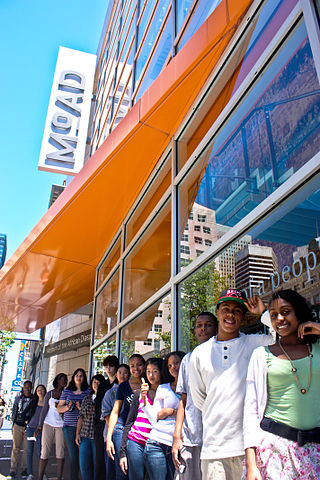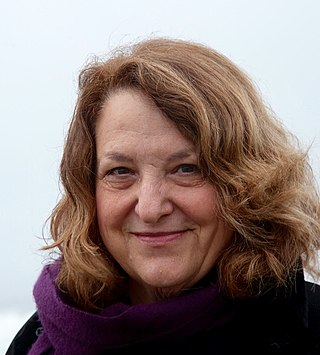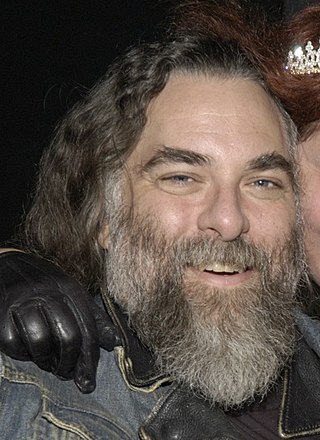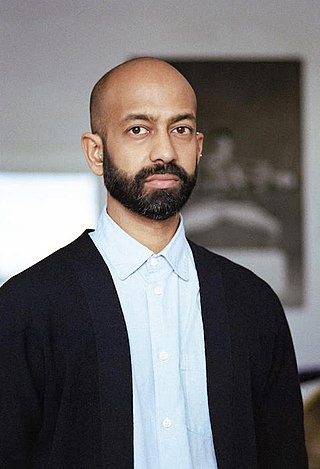Related Research Articles

Amy Sillman is a New York-based visual artist, known for process-based paintings that move between abstraction and figuration, and engage nontraditional media including animation, zines and installation. Her work draws upon art historical tropes, particularly postwar American gestural painting, as both influences and foils; she engages feminist critiques of the discourses of mastery, genius and power in order to introduce qualities such as humor, awkwardness, self-deprecation, affect and doubt into her practice. Profiles in The New York Times, ARTnews, Frieze, and Interview, characterize Sillman as championing "the relevance of painting" and "a reinvigorated mode of abstraction reclaiming the potency of active brushwork and visible gestures." Critic Phyllis Tuchman described Sillman as "an inventive abstractionist" whose "messy, multivalent, lively" art "reframes long-held notions regarding the look and emotional character of abstraction."

The Museum of the African Diaspora (MoAD) is a contemporary art museum in San Francisco, California. MoAD holds exhibitions and presents artists exclusively of the African diaspora, one of only a few museums of its kind in the United States. Located at 685 Mission St. adjacent to the St. Regis Hotel in the Yerba Buena Arts District, MoAD is a nonprofit organization as well as a Smithsonian Affiliate. Prior to 2014, MoAD educated visitors on the history, culture, and art of the African diaspora through permanent and rotating exhibitions. After a six-month refurbishment in 2014 to expand the gallery spaces, the museum reopened and transitioned into presenting exclusively fine arts exhibitions. MoAD does not have a permanent collection and instead works directly with artists or independent curators when developing exhibitions.

Lynn Hershman Leeson is a multimedia American artist and filmmaker. Her work combines art with social commentary, particularly on the relationship between people and technology. Leeson is a pioneer in new media, and her work with technology and in media-based practices helped legitimize digital art forms. Her interests include feminism, race, surveillance, and artificial intelligence and identity theft through algorithms and data tracking. She has been referred to as a "new media pioneer" for the prescient incorporation of new science and technologies in her work. She is based in San Francisco, California.

Nayland Blake is an American artist whose focus is on interracial attraction, same-sex love, and intolerance of the prejudice toward them. Their mixed-media work has been variously described as disturbing, provocative, elusive, tormented, sinister, hysterical, brutal, and tender.

Jessica Stockholder is a Canadian-American artist known for site-specific installation works and sculptures that are often described as "paintings in space." She came to prominence in the early 1990s with monumental works that challenged boundaries between artwork and display environment as well as between pictorial and physical experience. Her art often presents a "barrage" of bold colors, textures and everyday objects, incorporating floors, walls and ceilings and sometimes spilling out of exhibition sites. Critics suggest that her work is informed by diverse artistic traditions, including abstract expressionism, color field painting, minimalism and Pop art. Since her early career, they have noted in her work an openness to spontaneity, accident and marginality and a rejection of permanency, monetization and disciplinary conventions that Stephen Westfall characterized as an "almost shocking sense of freedom."

Michelle Lopez is an American sculptor and installation artist, whose work incorporates divergent industrial materials to critique present day cultural phenomena. She lives and works in Brooklyn, New York.

Ellen Harvey is an American-British conceptual artist known for her painting-based practice and site-specific works in installation, video, engraved mirrors, mosaic and glass. She frequently pairs traditional representational vocabularies and genres with seemingly antithetical postmodern strategies, such as institutional critique, appropriation, mapping and pastiche. Her work examines such themes as art as a mirror, interactions between built environment and landscape, ruins and the Picturesque aesthetic, and cultural and economic relationships between museums, artists and publics. Curator Henriette Huldisch writes of her work, "haunted as it is by the notion of art's ultimate futility, her paradoxical stake is in persistently testing art's possibility to do something in the world after all."
Jordan Wolfson is an American artist who lives in Los Angeles. He has worked in video and film, in sculptural installation, and in virtual reality.
Simparch is an American artist collective that was founded in Las Cruces, New Mexico in 1996. Presently this group is organized and maintained by founding members Matthew Lynch and Steve Badgett. Former members were Pat Finlay and Robert Hollinger. Their practice involves large-scale, usually interactive installations and works that, as the group's name suggests, examine simple architecture, building practices, site specificity and materials that may be salvaged, recycled or generally brought together with a kind of d.i.y. attitude. Often collaborating with other artists, builders, art critics, graffiti artists, filmmakers, and skate boarders, and musicians, Simparch works at providing sites which allow for social interaction and experimentation with design and materials.

Simone Leigh is an American artist from Chicago who works in New York City in the United States. She works in various media including sculpture, installations, video, performance, and social practice. Leigh has described her work as auto-ethnographic, and her interests include African art and vernacular objects, performance, and feminism. Her work is concerned with the marginalization of women of color and reframes their experience as central to society. Leigh has often said that her work is focused on “Black female subjectivity,” with an interest in complex interplays between various strands of history.
Public Fiction is a curatorial project and quarterly publication based in Los Angeles. It was founded in 2010 by Lauren Mackler.

Brendan Fernandes is a Canadian contemporary artist. He specializes in installation and visual art and currently serves as a faculty member at Northwestern University teaching art theory and practice.
Leonor Antunes is a Portuguese contemporary artist who creates sculptural installations. She lives and works in Berlin.
Won Ju Lim is a Korean American artist. She currently divides her time between Los Angeles, CA and Boston, MA.

Anna Sew Hoy is an American sculptor based in Los Angeles, California. She works primarily in clay, a medium she has been drawn to since high school. Sew Hoy’s works are abstract and blend found everyday items with uniquely crafted ceramic pieces to evoke a familiar yet uncanny response. Noting the performative aspect of working with clay, Sew Hoy has often engaged other artists to activate her sculptural installations through performance. Art critic Christopher Miles has called the artist’s work “utterly contemporary… in both its go-lightly cannibalism with regard to boomer-era agendas and preoccupations—from Funk art and folk craft to essentialist symbolism—and its openness to the cultural forms and detritus of its moment as legitimate grist for serious artmaking.”
Mia Locks is a contemporary art curator and museum leader.
Libby Black is an American contemporary artist working primarily in drawing, painting, and sculpture. Black lives and works in Berkeley California.

P. Staff is a contemporary visual and performance artist.

Harriet Korman is an American abstract painter based in New York City, who first gained attention in the early 1970s. She is known for work that embraces improvisation and experimentation within a framework of self-imposed limitations that include simplicity of means, purity of color, and a strict rejection of allusion, illusion, naturalistic light and space, or other translations of reality. Writer John Yau describes Korman as "a pure abstract artist, one who doesn’t rely on a visual hook, cultural association, or anything that smacks of essentialization or the spiritual," a position he suggests few post-Warhol painters have taken. While Korman's work may suggest early twentieth-century abstraction, critics such as Roberta Smith locate its roots among a cohort of early-1970s women artists who sought to reinvent painting using strategies from Process Art, then most associated with sculpture, installation art and performance. Since the 1990s, critics and curators have championed this early work as unjustifiably neglected by a male-dominated 1970s art market and deserving of rediscovery.
Xiaoyu Weng (翁笑雨) is a Chinese curator, writer, editor and educator in the area of contemporary art.
References
- ↑ Neykov, Vera (October 7, 2013). "In the Golden Room". Interview Magazine . Brant Publications, Inc. Retrieved March 6, 2016.
- ↑ "Visiting Artist Lecture: Samara Golden '95, Fine Arts Lecture". Mcad.edu. Minneapolis College of Art and Design. 2018. Retrieved November 22, 2018.
- 1 2 3 Locks, Mia. "Samara Golden: The Flat Side of the Knife". MOMA PS1. Retrieved March 6, 2016.
- ↑ Soto, Paul (September 2012). "Samara Golden and Davida Nemeroff Face the Press". Art in America . Brant Publications. Retrieved February 5, 2017.
- ↑ Berardini, Andrew (March 2013). "Future Greats 2013". ArtReview . ArtReview Ltd.: 96.
- ↑ "Whitney Biennial". Whitney.org. 2017. Retrieved November 7, 2018.
- ↑ Damman, Catherine (2016). "Critics' Picks: San Francisco – Samara Golden". Artforum.com . Retrieved November 10, 2018.
- ↑ Slenske, Michael (March 16, 2016). "A room with a view: Samara Golden's installations in San Francisco". Wallpaper.com . Retrieved November 9, 2018.
- ↑ Tang, Jo-ey (May 17, 2016). "Samara Golden Yerba Buena Center for the Arts / San Francisco". Flashartonline. com. Retrieved November 9, 2018.
- ↑ Emory, Sami (March 22, 2016). "Artist Builds 18 Upside Down Rooms into a Gallery's Ceiling". Vice.com. Retrieved November 9, 2018.
- ↑ Kaack, Nicole (April 23, 2016). "Little Boxes: Samara Golden at Yerba Buena". Artcritical.com. Retrieved November 9, 2018.
- ↑ Behringer, David (October 21, 2015). "When Walls Become Floors: The Art of Samara Golden". Design-milk.com. Retrieved November 13, 2018.
- 1 2 Rodney, Seph (October 23, 2015). "The Eerie Abandoned Dreams of Samara Golden". Hyperallergic . Retrieved November 13, 2018.
- 1 2 Johnson, Ken (October 8, 2015). "Samara Golden's New Point of View in 'A Fall of Corners'". The New York Times. Retrieved November 13, 2018.
- ↑ Gat, Orit (October 21, 2015). "Reviews / Samara Golden". Frieze.com . Retrieved November 13, 2018.
- ↑ Skidmore, Maisie; Rigg, Natalie (October 6, 2016). "AnOther's Highlights From Frieze Art Fair 2016". AnOtherMag.com. Retrieved November 13, 2018.
- ↑ Johnston, Kathleen (October 10, 2016). "Frieze London's 10 most Instagrammed artworks". GQ-magazine.com . Retrieved November 13, 2018.
- 1 2 Kron, Cat (September 2015). "Openings: Samara Golden". Artforum . Retrieved November 9, 2018.
- 1 2 Pechman, Alexandra (October 27, 2014). "Reflections of Samara Golden". Wmagazine.com . Condé Nast. Retrieved November 21, 2018.
- ↑ "Samara Golden at MoMA P.S. 1". Contemporary Art Daily. August 21, 2015. Retrieved November 21, 2018.
- ↑ Solway, Arthur (2016). "Overpop". ArtAsiaPacific. Retrieved November 22, 2018.
- ↑ "Samara Golden". Hammer Museum. Retrieved March 6, 2016.